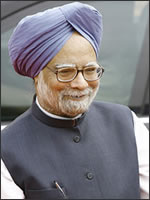India Courts Africa

 |
| India's Prime Minister Manmohan Singh |
India is not a “new player” in Africa. Contacts between India and Africa can be traced back to ancient times. Jawaharlal Nehru had observed that “though separated by the Indian Ocean … Africa is in a sense our next door neighbour.” Support for anti-colonial movements and the anti-apartheid struggle were pillars of India’s Africa policy during the Cold War. The emergence of a democratic South Africa in 1994 was indeed a victory for India, as it was the first country to bring the issue of apartheid to the United Nations. But the fact remains that Africa was largely viewed in the context of solidarity with the developing world.
To an extent, India’s growing relations with Africa are a reflection of changes in its foreign policy since the mid-1990s. Over the last decade or more, India has been pursuing a policy of engaging all regions of the world. It has wooed the countries of East Asia with its ‘Look East’ policy, established diplomatic relations with Israel, entered into a strategic dialogue with the United States, reworked its relations with China and endeavoured to re-establish linkages with South American countries. As part of its current foreign policy approach, India has also started looking at building relations with African countries within the frame work of common interests.
Given the rapid strides that its economy has been making in recent years, India has been eyeing Africa’s abundant hydrocarbons and other natural resources. Indian oil majors like the Oil and Natural Gas Corporation Videsh Limited (OVL) have invested in assets in Sudan, Ivory Coast, Libya, Egypt, and Nigeria, Nigeria-Sao Tome Principe Joint Development Area and Gabon. OVL invested US $750 million to acquire a 25 per cent partnership in the Greater Nile Petroleum Company (GNOP) in Sudan in March 2003. As of now, India gets 3.23 million tonnes of equity oil from GNOP. Private sector companies like Reliance have also invested in equity oil in Sudan. India recently completed a $200 million pipeline project that links Khartoum and Port Sudan on the Red sea. It is also negotiating with Chad, Niger and Angola. Recently, in a strategic move to acquire downstream assets abroad, Reliance industries acquired a majority stake in the management and control of an East Africa based oil retail distribution company, Gulf Africa Petroleum Corporation (GAPCO). GAPCO owns storage depots all over East and Central Africa and operates terminals in Kenya, Tanzania and Uganda.
For their part, African countries have acknowledged the growth of the Indian economy and have expressed a desire to emulate the Indian model. They feel that India provides a “model to manage gradual economic transformation” and help them move from “abject poverty to higher levels of development.” The Indian leadership has in recent years framed the relationship with Africa as one of partnership. As Prime Minister Manmohan Singh noted during his visit to Nigeria last year, “Our Partnership will be based on the fundamental principles of equality, mutual respect and mutual benefit.”
In the last decade, India has launched a number of initiatives towards closer co-operation with Africa, including the Focus Africa programme launched as part of the Export Import (EXIM) policy in 2001 to increase trade with the continent. Realizing the need to enhance co-operation with West and Central African countries, in particular, the Techno- Economic Movement for Co-operation between nine African countries and India (TEAM 9) was initiated in 2003. The India-Africa project partnership conclaves held in 2004, 2005 and 2006 are reflective of growing investment and trade ties. India Africa bilateral trade has grown from $5.4 billion in 2001-02 to $11.8 billion in 2005-06.
India must take care not to adopt a patronizing attitude towards Africa. The continent should not be viewed through the prism of ‘band-aid diplomacy’. Recent decades have witnessed grandiose aid packages offered to African countries by Western powers, including Tony Blair’s suggestion of a ‘big push’ and George Bush’s anti-malaria plan as well as the Presidential AIDS initiative. While these commitments are indeed commendable, in reality not all of them have been fulfilled. At the Gleneagles summit in 2005, G8 leaders had promised to double their annual foreign aid from $25 billion to $50 billion by 2010, with at least half of the money earmarked for Africa. After almost three years, they are only 10 per cent of the way to their target. Moreover, aid packages no longer excite Africans, who instead are on the look out for fresh investments and joint partnerships to attain sustained economic growth.
African countries have been interested in acquiring cost effective and intermediate technology from India. They have expressed special interest in forging partnership in areas such as Information Technology, agriculture, health and pharmaceuticals. Only half a million Africans have access to the internet, and there is thus a pressing need to narrow the “digital divide”. African countries want to benefit from India’s prowess in the field of IT. African leaders often quote the example of India’s green revolution and its attainment of self sufficiency in food production. India’s expertise in this sector can help to develop the African potential. The growing spread of diseases such as malaria, tuberculosis and HIV AIDS have made health an important agenda for most African governments. Here, India has the advantage of offering medicines and drugs at substantially lower costs compared to major Western firms. The time is thus ripe for India to forge a mutually beneficial partnership, taking advantage of the goodwill that exists for it in Africa.
Earlier published in IDSA Strategic Comments March 19, 2008
